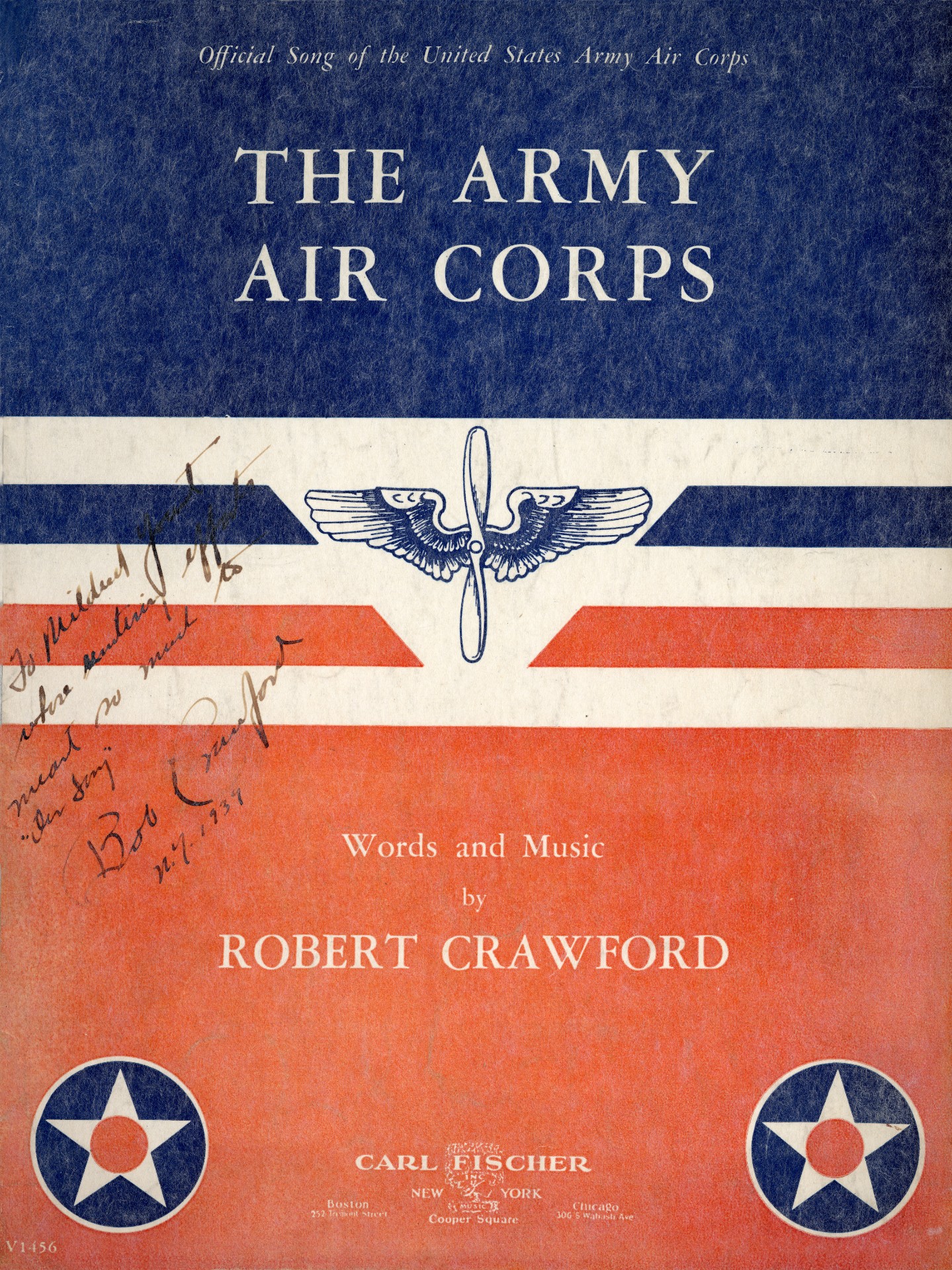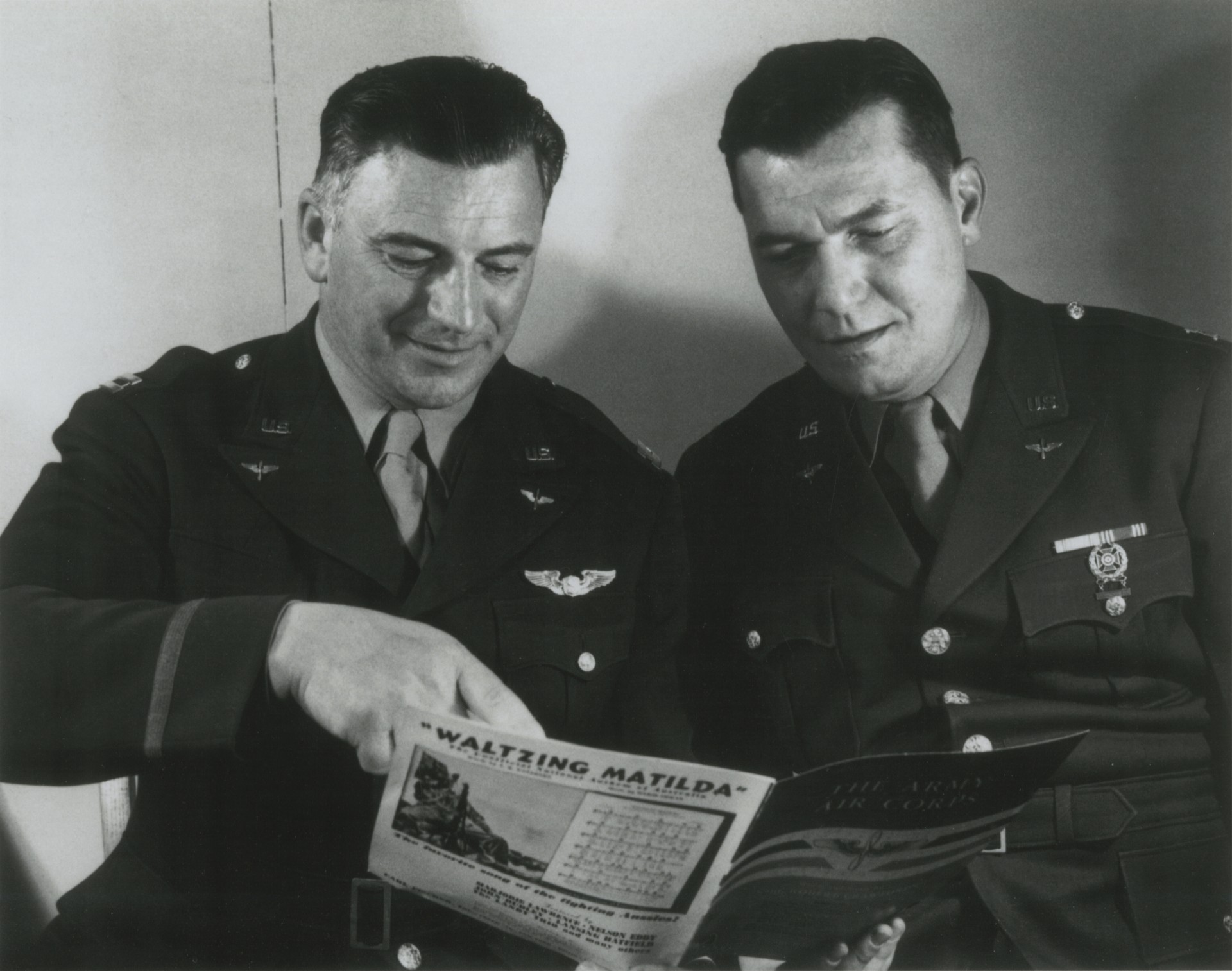The official song of the United States Air Force was the result of unrelenting efforts by two of the Air Force’s most iconic names, Major General Oscar Westover, Chief of the Air Corps, and General Henry H. Arnold, General of the Air Force. These two legendary leaders wanted a song for the Air Branch that would be equal in stature to the service songs of the Army, Navy, Marine Corps and Coast Guard.Their intense desire for an Air Force song was realized through the efforts of the civilian community by way of Bernarr MacFadden, who announced in Liberty magazine (page 38, September 10, 1938 edition), that the periodical would offer a $1,000 prize for a song, which if approved would be designated as the official song of the Army Air Corps (AAC). The contest would be open until June 30, 1939. The following is an excerpt of the original text of this announcement and indicates the intended goals of the song.
|
.jpg?ver=2019-11-08-160228-480)
Major General Oscar Westover
Chief of the Air Corps
|
.jpg?ver=2019-11-08-160500-217)
Five-Star General Henry H. Arnold
General of the Air Force
|
|
|
|
The Army Air Corps(1939)
The U.S. Air Force(1947)
Words and music by Robert M. Crawford (Lt. Col. USAAF/USAF)
b. July 27, 1899–d. March 12, 1961
.jpg?ver=2019-11-14-124713-447)
Army Air Corps Song Contest Announcement
Chronology of The United States Air Force Song
1938
September 19, 1938 - Call for compositions announced via Liberty magazine.
1939
June 30, 1939 - Contest deadline; extended to July 15, 1939, due to no clear winners.
At General Arnold's request, both Meredith Willson and Irving Berlin submitted songs. Both compositions failed to satisfy the committee.
Just days prior to the end of the extended deadline, Mrs. Mildred A. Yount (wife of Lt. Gen. Barton K. Yount) and chairwoman of the song committee lamented, "We received over 700 manuscripts and only a few were worth taking to the musical experts that we had decided to consult."
July 13, 1939 - Mrs. Yount receives an unprecedented phone call from the Information Division, Air Corps Headquarters for her to listen to a last-minute submission. The following is Mrs. Yount's recollection of this historic encounter:
"Mr and Mrs. Crawford arrived in short order. I didn't have long to feel sorry for the plight of the chair-woman of the song committee. The committee had a strict rule against listening to entrants sing their compositions to the group as a whole or to individual members. I explained to them.... I did not listen to songs... that nothing could be done without the manuscript. Mr. Crawford said he didn't have the manuscript but he had a recording. From this brief encounter, this original sketch was created."
As it turned out, at the urging of Mrs.Crawford, Mrs. Yount did listen to Robert sing his song and was not sure if she was captivated by his voice or the song itself. The next day, the tune stuck in her head and she remembered the advice of Colonel Edmond L. Gruber (U.S. Army, ret.), composer of The Caissons Go Rolling Along.
"When you find a song you will like it," the colonel said, "it will come from a young flyer, one who has the feel of flying in his bones and knows the thrill and glamour of the Air Corps."
.jpg?ver=2019-10-02-120133-647) |
Robert Crawford’s song was selected by the Army Air Corps Committee as the winner of the competition. This rough sketch was actually written on July 13, 1939 at the direction of Mildred Yount in order for Crawford to meet the deadline to submit his song. Robert dated his sketch with the month and year he mentally composed the song while flying from Bridgeport, Connecticut to Trenton, New Jersey. He recorded the exact date as May 11, 1939.
|
July 30, 1939 - Major General H. H. Arnold, Chief of the Air Corps, applied to ASCAP in behalf of the Army Air Forces for a blanket release for the "Army Air Corps" song on all programs sponsored by the Air Corps or any of it's units.
August 1, 1939 - John G. Payne replied in behalf of ASCAP granting a blanket release, to the Army Air Forces "this release is completely unrestricted and you may feel perfectly free to the composition The Army Air Corps in any way you choose.
August 13, 1939 - With the song written but not yet approved, Carl Fischer begins engraving the initial copies of the voice and piano edition for publication.
August 18, 1939 - Maj Gen H. H. Arnold, Chief of the Air Corps, verbally approved The Army Air Corps as the official song of the Army Air Corps.
August 19, 1939 - The official letter from General Arnold was drafted, signed and sent; Crawford was asked to keep the announcement confidential.
Following his acceptance of Robert Crawford’s “The Army Air Corps” in 1939, General Arnold had a vested professional interest in creating a first-rate musical organization especially in view of his desire to have a separate Air Force. Because of his intense appreciation for the power of music, he personally monitored and supported the Army Air Forces’ Band program.
Now all that was needed was a truly great military band dedicated to performing “The Army Air Corps” with all the bravura and vigor the song demands. In order to do this and remain on par with the other premier service bands, the AAF Band would require Airmen Musicians with all of the talent and skill necessary to represent the world’s greatest Air Force. With renewed invigoration, US Army leaders shared a special interest in rebuilding the band program for the U.S. Army and the Army Air Forces.
Knowing the “vital mission” and the impact of military bands on the American public, both General Arnold and his successor, General Carl A. Spaatz (the first chief of staff of the U.S. Air Force) built and refined an Air Force Band program second to none.
September 2, 1939 - The Army Air Corps song was introduced and received its premiere indoor performance by Robert Crawford at the Inaugural Ball, National Air Races, Cleveland, Ohio.
.jpg?ver=2019-11-13-113635-187)
Crawford poses for a photo with representatives from Liberty Magazine, Cleveland, OH.
.jpg?ver=2019-11-13-112504-733)
Brigadier General Barton K. Yount (center) was the key speaker for the gala dinner on November 2, 1939, at which time a check for $1,000 was presented to Robert Crawford (left) by Mr. McFadden (right), sponsor of the contest.
Carl Fischer, Inc. executed a performance release to the government. This release cleared the copyright for unrestricted rights to public performance of The Army Air Corps song by the uniformed forces of the United States or by any civilian performers in conjunction therewith.
October 28, 1939 - Military band version published with added trio from a separate song Crawford had composed entitled Here’s a Toast to the Host.
1940
January 15, 1940 - Male Quartet version published
February 3, 1940 - Vocal orchestration published
Carl Fischer authorized the War Department to use the The Army Air Corps in two song books to be published by it.
1941
July 30, 1941 - Major General H.H. Arnold, Chief of the Air Corps, applied to ASCAP in behalf of the Army Air Forces for a blanket release for The Army Air Corps song on all programs sponsored by the Air Corps or any of its units.
August 1, 1941 - John G. Payne replied in behalf of ASCAP granting a blanket release, to the Army Air Forces “this release is completely unrestricted and you may feel perfectly free to use the composition The Army Air Corps in any way you choose.” The author, Mr. Robert Crawford, cooperated in every way.
1942
February 3, 1942 - Vocal orchestration published
April 1942 - At the request of Carl Fischer ASCAP sent out a special release of “The Army Air Corps” song to its entire list of licensees.

1st edition publication, autographed by the composer to Mrs. Mildred Yount, the chairwoman of the AAC song committee.

Capt. Robert Crawford, composer of The Army Air Corps, discusses his song with Capt. Alf Heiberg, founding conductor of the official band of the Army Air Forces. Crawford, dubbed by Time magazine as “The Flying Baritone” performed his song with The Army Air Forces Band on several National Broadcasting Company (NBC) radio broadcast.
1943
Samuel Barber arranges The Army Air Corps song in a minor key and entitles it Funeral March. In all likelihood, this work may have been done in preparation for the State Funeral in honor of Franklin Delano Roosevelt, 32nd President of the United States. To date, no official records have been located to confirm this information.
Funeral March, Samuel Barber
Preeminent American composer Samuel Barber served in the U.S. Army Air Forces (USAAF) from 1942 to 1945
1947
The National Security Act of 1947 became law on July 26, 1947. Under the Department of the Air Force, the act established the United States Air Force, headed by the Chief of Staff, USAF. On Sept. 18, 1947, W. Stuart Symington became Secretary of the Air Force, and on Sept. 26, Gen. Carl A. Spaatz became the USAF's first Chief of Staff.
1948
January 12, 1948 - Secretary of Air Force Symington requested the advisability of changing the present lyrics for the “Army Air Corps” song to reflect the Air Force’s status as a separate service.
1949
 |
May 13, 1949 - Air Force Chief of Staff General Hoyt S. Vandenberg informed Major Robert Crawford (USAFR) that the Department of the Air Force had approved the new words, as revised and recommended by both Robert Crawford and Colonel George S. Howard. The sheet music with the new words would not be published until all existing supplies of The Army Air Corps was sold. The second edition, pictured here, is the 1951 printing, retitled to reflect new title The U.S Air Force.
|
1951
Carl Fischer, Inc., copyrighted the new lyrics with title changed to “The U.S. Air Force."
1961
Robert Crawford’s devotion to Alaska brought him to New York in 1960 for an extended stay to complete a musical honoring the 49th state on which he had already done a substantial work. Crawford passed away on March 12, 1961.
1965
February 27, 1965 - In recognition of Lt. Col. Robert Crawford’s contributions to our nation and our Air Force, the Air Force Scroll of Appreciation in his honor was presented posthumously to Mrs. Hester Crawford by Major General Marvin L. McNickle at a parade on the flight line at Homestead AFB.
“Few can leave such a heritage to airmen everywhere..."
-General Thomas Dresser White, the 4th Chief of Staff of the U.S. Air Force, Washington, D.C.
The first page of the original piano vocal manuscript to The U.S. Air Force was carried to the surface of the moon on July 30, 1971 aboard the Apollo 15 “Falcon” lunar module. The first and only all Air Force crew included AF Colonels David R. Scott, Alfred M. Worden, and James B. Irwin.
They arranged to take the sheet music with them as a tribute to Robert Crawford and the United States Air Force. When they returned, each one signed the bottom of the first page prior to returning it to The National Museum of the United States Air Force, Wright Patterson AFB, OH.